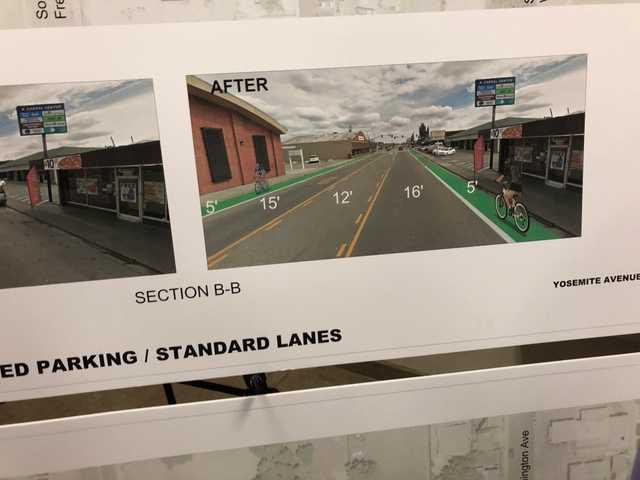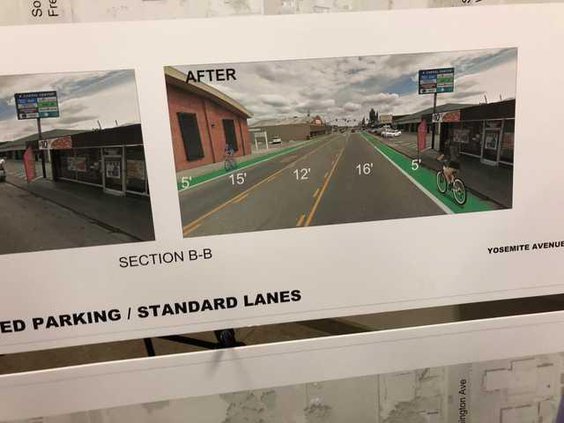Almost 85 percent of the $5.7 million cost of three projects aimed at enhancing the safety of bicyclists and pedestrians as well as eliminating rough pavement on Yosemite Avenue and Main Street won’t be on the dime of Manteca taxpayers.
The city has successfully secured $2.1 million in Measure K funding that is set aside specifically for bicycle and non-motorized transportation from the San Joaquin County Council of Governments.
u$1,440,000 will go toward the cost of Manteca’s first multi-use path and bridge crossing the 120 Bypass that’s designed for bicyclists and pedestrians. The project planned such south of the Union Road interchange carries a price tag of $1.5 million.
u$144,000 to pay for the cost of highly visible solid green bicycle lanes as part of the Yosemite Avenue corridor pavement upgrade project from Main Street to Cottage Avenue that will take place this summer.
u$210,000 to pay for the cost of highly visible solid green bicycle lanes as part of the Main Street corridor pavement upgrade project from Atherton Drive to Yosemite Avenue that will take place this spring.
u$240,000 for developing a Non-motorized Transportation Plan: The plan will highlight development related projects and address connecting existing facilities to other existing facilities as well as connections to future development. The grant is covering 80 percent of the plan’s cost.
The city already secured $2.4 million in federal funds toward the improvement of Main Street between Yosemite Avenue and Atherton Drive as well as Yosemite Avenue between Main Street and Cottage Avenue. The cost of those two projects — including bike lanes — is pegged at $3.3 million. The balance of the tab will be covered by Measure K sales tax and gas tax revenue.
The bike lanes are expected to make traveling safer for bicyclists due to the width and the solid coloring even though they are still Class II which means they are on the same road with vehicles. It will tie in with Manteca High as well as downtown with connecting points with both the Tidewater Bikeway and Spreckels Avenue Bike Path.
The separate bridge across the bypass will separate pedestrians and bicyclists from vehicle traffic. Currently none of the overpasses of the 120 Bypass — Airport Way, Union Road or Main Street — have sidewalks or and protection for bicyclists from vehicles such as the concrete K-rail barrier on the almost completed 11th Street replacement bridge across the Union Pacific Railroad tracks in Tracy.
The pedestrian/bicyclist bridge is part of the diverging diamond interchange project breaking ground this year at Union Road and the 120 Bypass. It will be the first such interchange in California
Manteca opted to pursue a diverging diamond interchange for Union Road instead of upgrading the existing structure to a partial cloverleaf.
The diverging diamond design calls for traffic lanes crossing on either side of the bridge structure so northbound traffic would cross the bridge on the west side instead of the east side with the southbound lanes on the east side instead of the west side. Once they clear the bridge they are switched back.
The on and off ramps along with the flipping of the lanes creates two semi-diamond shaped intersections on either side of the bridge. This eliminates the need for traffic from both directions on Union Road as well as that coming from the 120 Bypass avoid needing any traffic signals to exit an off ramp or to get into an on ramp. The project will also include ramp meter signals such as now are in place on the Lathrop Road/Highway interchange.
The design could slash as much as $10 million from the $25 million estimated cost of converting Union Road into a partial cloverleaf.
While the design improves traffic flow significantly and reduces the accident rate it doesn’t get high marks necessarily for improved pedestrian and bicyclist safety.
The council in 2016 opted to put pedestrian safety on equal footing with traffic flow by including what could be a $1.5 million pedestrian/bicycle path that would eliminate the need for either to have to cross off- and on-ramp traffic or pedal alongside traffic moving at 40 mph in order to cross the 120 Bypass.
There are diverging diamonds designs that keep the bike lane and sidewalk or separated bike path for bicyclists and pedestrians to share on both sides of the crossing. In doing so, pedestrians and bicyclists are left to cross traffic turning into and off the freeway without protection of traffic lights. If traffic lights were added it would defeat the purpose of eliminating stops for vehicles and not increase the volume that the ramps could handle.
The bottom line for Manteca taxpayers between funding from other sources and the city’s staff at successfully working with Caltrans to allow the state’s first diverging diamond interchange to be built in Manteca is a combined savings or avoidance of expenditures of $14.1 million to deliver what will be $20 million plus worth of road and safety improvements.
To contact Dennis Wyatt, email dwyatt@mantecabulletin.com
WIN-WIN FOR MANTECA
Safer, smoother streets with 85% of cost covered by other sources





